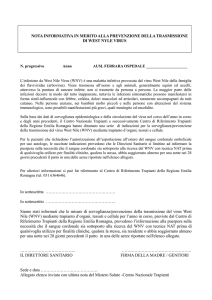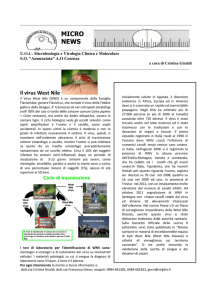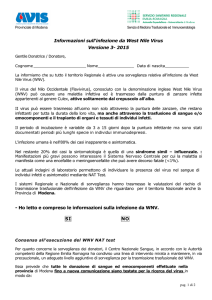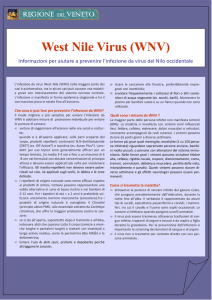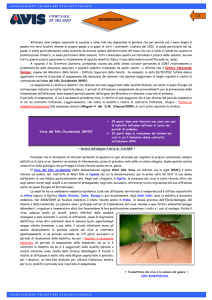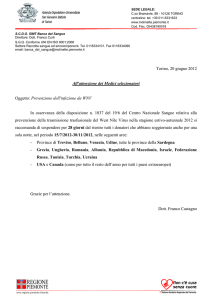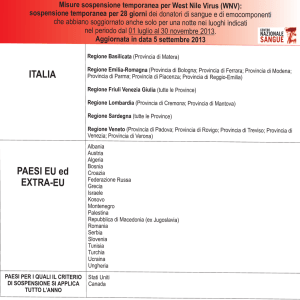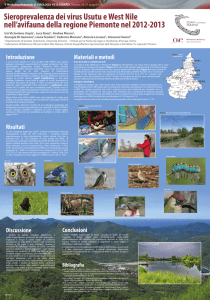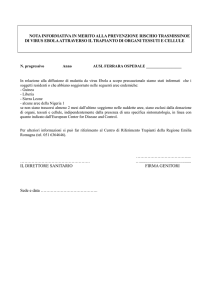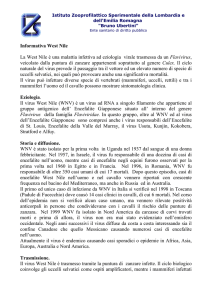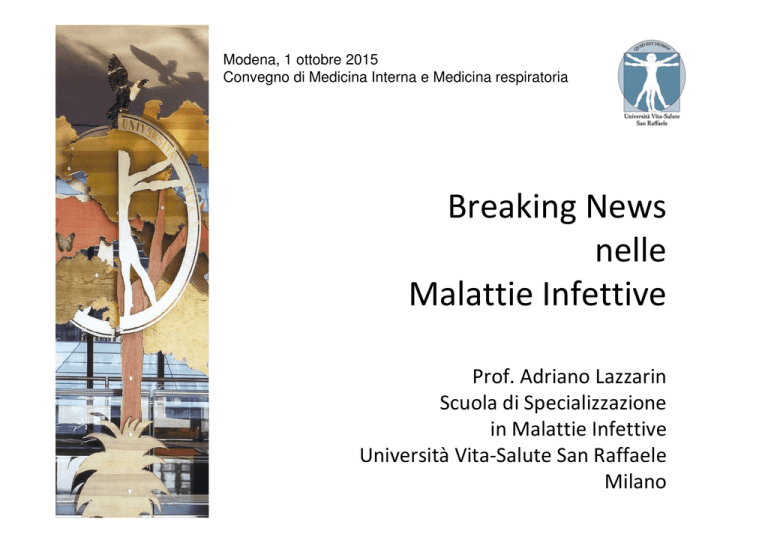
Modena, 1 ottobre 2015
Convegno di Medicina Interna e Medicina respiratoria
Breaking News
nelle
Malattie Infettive
Prof. Adriano Lazzarin
Scuola di Specializzazione
in Malattie Infettive
Università Vita-Salute San Raffaele
Milano
Italy: Patient Zero
Trasport with Italian Air Force aircraft KC 767.
Arrival at Pratica di Mare, 24 Nov 2014
Physician, 50 yrs old, Emergency
First mission in Sierra Leone
Not clear how he became infected
Experimental treatment with drugs
and convalescent plasma
Discharged 2 Jan 2015
Trattato di medicina interna sistematica
Malattie Infettive:
modello didattico per la formazione del giovane medico
Epidemiologia
Eziologia
Patogenesi
Diagnosi
Cura
The virus present in the
infected secretion enters
through the mucosal or
percutaneous way.
The virus actively replicates in:
•Macrophage/monocytes
•Dendritic cells
•Endothelial cells
and spreads through the blood
stream
Main target organs:
•liver
•kidney
•spleen
•ovary
•testis
•lymphonoid organs
Feldmann, Lancet 2011
TEMPO
LUOGO
SPAZIO
DEADLINES Case fatality rate
CONTAGIOUSNESS Average basic reproduction number (Ro)
no. of people one person will likely infect
Diagnosi e cura
Eziopatogenesi
Epidemiologia
Prevenzione
“No city on the earth is now more than 24 hours away from any other”. Economist 2003
“Annually, the world's airlines carry a staggering total approaching some two billion passengers.
At any one moment, about half a million people world-wide are flying in commercial aircraft“.
Select Committee on Science and Technology Fifth Report UK Parliament 2000
Severe Acute Respiratory Syndrome (SARS)
Clinical manifestations of SARS:
2-10 days: fever, myalgia, malaise and chills
next 8-12 days: cough, shortness of breath, tachypnea
3rd phase: progressive hypoxia and require intubation
and mechanical ventilation
systemic symptom: lymphopenia
early phase chest radiographs often show peripheral
pulmonary infiltrate
Peiris et al 2003 Lancet 361:1767-42
…. but within 5 months (Feb(Feb-July)
Virus identified
Diagnostic tests developed
Infection control practices established
International public health response
Surveillance programs established
5 July: WHO removed the last region from the
list of areas with recent local transmission
SARS left in its wake….
8,098 cases, 774 deaths
Billions lost in airlines,
tourism
World wide economic down
turn
Devastated health care
system
A livello globale, da settembre 2012, l’OMS ha notificato
1.542 casi confermati in laboratorio di infezione da MERS-CoV,
tra cui almeno 544 decessi correlati.
MER-CoV
Data la mancanza di evidenze di trasmissione sostenuta da
persona a persona in comunità, l’OMS non raccomanda
alcuna restrizione a viaggi o a rotte commerciali.
E’ buona prassi di sanità pubblica sensibilizzare i viaggiatori
da e verso paesi colpiti da MERS-CoV.
• Ebola is a little river in the North of Yambuku (Democratic Republic of Congo,
former Zaire)
• The first isolate was obtained from a patient from Yambuku village
Ebola Virus
Prototype Viral Hemorrhagic Fever
Pathogen
– Filovirus: enveloped, non-segmented, negative-stranded RNA virus
– Severe disease with high case fatality
– Absence of specific treatment or vaccine
> 20 previous Ebola and
Marburg virus outbreaks
2014 West Africa Ebola
outbreak caused by Zaire
ebolavirus species (five known
Ebola virus species)
18
Impossibile v isualizzare l'immagine.
•As of Jan 28, at least 38 cases outside of Africa (Europe and US)
•Mostly repatriated
http://ebola.nextflu.org/
EVD Summary
The 2014 Ebola outbreak in West Africa is the largest
in history and has affected multiple countries.
Think Ebola: U.S. healthcare providers should be
aware of clinical presentation and risk factors for EVD.
Human-to-human transmission by direct contact
• No human-to-human transmission via inhalation
(aerosols)
• No transmission before symptom onset
Early case identification, isolation, treatment and
effective infection control are essential to prevent Ebola
transmission.
West Nile virus
Life cycle and
transmission
Source: http://www.malwest.gr
RIP-1
ubiquitination
TL3 signaling
Complement
activation
Membrane
rearrangements
Evasion of Mda5mediated type I
IFN response
JAK/STAT
signaling
STAT1
phosphorylation
IFNβ
transcription
3’ UTR
5’ UTR
Non-structural
Structural
C prM E
Capsid
NS1 2A 2B
4A 4B
NS5
Matrix
NS2
B
Envelope
WNV genome
NS3
Secreted and
on cell surface
NS3
NS1
Protease
Helicase
NTPase
RTPase
NS5
RdRP
MTase
WNV lineage 1 and WNV lineage 2 strains circulating in European and
neighboring countries belong to four phylogenetic clusters geographically
related to bird migratory routes
The complex epidemiological scenario of WNV in Italy
WNV Lin2/14 (Volgograd)
WNV Lin2/11
(Hungary)
WNV Lin1/11-13 (Livenza)
WNV Lin1/11 (Piave)
WNV Lin1/08-09 (Po river)
WNV Lin2/12-14
(Hungary)
WNV Lin1/98 (Tuscany)
WNV Lin2/11
(Hungary)
WNV Lin2/11-12 (Hungary)
WNV Lin1/11 (Oristano)
Updated from Barzon et al. Int J
Environ Res Public Health 2013
Gobbi et al. BMC Infect Dis 2014
Clinical presentation of WNV infection
• West Nile neuro-invasive disease (<1%)
• Encephalitis
• Aseptic meningitis
• Acute flaccid paralysis
(Elderly and immunocompromized individuals
are the most affected).
• West Nile fever (~20%)
• “benign” influenza-like illness
• Asymptomatic (~80%)
Petersen et al. ,
JAMA 2013
Cronaca → nozionismo/
Metodologia clinica → formazione
Non-Neuroinvasive Disease
• Mild WNV infection
• Incubation:
2-14 days from mosquito bite
• Febrile illness of sudden onset
• Symptoms - generally last 3-6 days:
– Malaise/weakness/fatigue
– Nausea/vomiting/anorexia/diarrhea
– Eye pain, conjunctivitis
– Headache, sore throat, myalgia
– Rash*
– Lymphadenopathy
*Erythematous maculopapules
(neck, trunk, arms and legs)
19%–57% of cases
WNV Myelitis
• Acute Flaccid Paralysis (AFP)
• Focal weakness in 50% w/CNS infection
• Progresses to paralysis in ≈ 35%
–
–
–
–
–
Rapidly progressive (2-8 d from onset)
LMN pattern
Typically proximal musculature
Sphincteric dysfunction possible
Quadriparesis, paraparesis, or monoplegia
• Poliovirus ≠ encephalopathic
• GBS ≠ fever, CSF pleocytosis, rash, back
pain
• Respiratory muscle weakness can require
prolonged mechanical ventilation
•
EMG:
-Anterior horn cells process (axonal neuropathy)
-Not demyelination
Kinetics of WNV RNA and antibody response after primary
infection with WNV
Detection of WNV RNA and antibodies
WNV RNA and antibody response in viremic blood donors during follow-up
serum WNV IgG
serum WNV IgM
WNV RNA in urine
WNV RNA in plasma
1
3
5
7
9
60
120
180 240
Time (days after index donation)
300
360
Laboratory diagnosis of WNV infection
Barzon et al., Expert Rev Anti Infect Ther 2015
Recommendations on the use of laboratory tests for the
diagnosis of WNV infection
Barzon et al., Expert Rev Anti Infect Ther 2015
Are physicians ready to hit the EID?
Some features that should be carefully
kept in mind:
Clinical presentation of emerging
diseases (key-symptoms)
Geographical provenience of patient
Outbreak currently occurring worldwide
AIDS - a new disease fought with an
integrated approach: main concerns
extensive spread before noticed
good outbreak investigation
multiple methods of spread
quickly discovered how to prevent
quickly discovered good diagnostic test
no vaccine
short wait of specific drugs
but AIDS is still a global disaster
EPIDEMIOLOGIA
PREVENZIONE
STOP
EBOLA
SINTOMATOLOGIA
PREVENZIONE
STOP
SarS
EZIOPATOGENESI
CURA
STOP
AIDS
PREVENZIONE
CURA
STOP
HCV
EPIDEMIOLOGIA
(VETTORI)
DIAGNOSI
STOP
West Nile
Conclusioni (1)
La comparsa di nuove infezioni o il
cambiamento della ricettività dell’ospite, nel
corso degli anni, può cambiare notevolmente
la priorità da dare all’apprendimento di una
singola malattia infettiva.
Ciò che, quasi sempre, accomuna le diverse
infezioni è il metodo con il quale va affrontato
l’algoritmo della diagnosi e cura di ciascuna.
Conclusioni (2)
La particolare importanza dell’anamnesi (tempo,
luogo e modalità di esposizione all’agente eziologico
e ai suoi vettori), la relativa facilità di conoscerne la
causa a differenza di altre malattie d’organo, le
caratteristiche della risposta immune individuale, la
peculiarità di alcune manifestazioni cliniche (malattie
esantematiche) e la possibilità di arrivare nella
maggioranza dei casi a una rapida guarigione, con o
senza l’aiuto di antimicrobici, fanno della malattia
infettiva un modello didattico lineare di metodologia
clinica.
Modena, 1 ottobre 2015
Convegno di Medicina Interna e Medicina respiratoria
Breaking News
nelle
Malattie Infettive
Prof. Adriano Lazzarin
Scuola di Specializzazione
in Malattie Infettive
Università Vita-Salute San Raffaele
Milano

